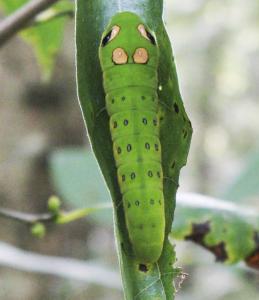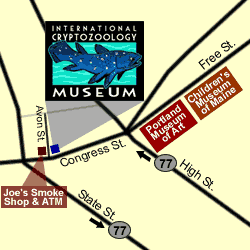When A Cryptic Species Is An Insect
Posted by: Loren Coleman on November 28th, 2009
Sometimes semi-cryptids, known species of animals seen by native peoples beyond where they are normally known, in time and space, but unproven by zoologists (yet), apparently can be insects.
Take, for example, Papilio troilum, which a few folks felt were in Maine, although it officially had not been acknowledged as living in the state for three-quarters of a century.
The only documented Maine sighting was in 1934, noted wildlife biologist Phillip deMaynadier.

It had been 75 years after that last reported sighting of a spicebush swallowtail caterpillar or butterfly in Maine. Now evidence and photos of the caterpillars have been verified by the Maine Department of Inland Fisheries, by Phillip deMaynadier, who took the above image.
In September 2009, deMaynadier found several occupied swallowtail nests in some hardwood swamps in Berwick and Wells. The finding proves that the butterfly breeds in Maine, he said.
“This is now officially one of the largest, most colorful butterflies in the state, and somehow it slipped under our radar screen for the past 75 years,” deMaynadier said.

The adult spicebush caterpillar.
For more, see here.
++++
The International Cryptozoology Museum will be closing early on Saturday, November 28th. Hours for this one Saturday will be from 11:00 am to 4:00 pm (instead of 6 pm). Normal hours resume for Sunday, November 29th, Noon to 5:00 pm. Closed Monday, and back to 11-6 pm then Tues-Sat again.
Five dollars per person, any age, for admission, cash or check. There is an ATM next door at Joe’s Smoke Shop.
Bigfoot and Yeti Christmas ornaments have arrived. Other popular cryptozoological items and autographed books are available.
I will have extended hours on the Saturday before Christmas, December 19th.
About Loren Coleman
Loren Coleman is one of the world’s leading cryptozoologists, some say “the” leading living cryptozoologist. Certainly, he is acknowledged as the current living American researcher and writer who has most popularized cryptozoology in the late 20th and early 21st centuries.
Starting his fieldwork and investigations in 1960, after traveling and trekking extensively in pursuit of cryptozoological mysteries, Coleman began writing to share his experiences in 1969. An honorary member of Ivan T. Sanderson’s Society for the Investigation of the Unexplained in the 1970s, Coleman has been bestowed with similar honorary memberships of the North Idaho College Cryptozoology Club in 1983, and in subsequent years, that of the British Columbia Scientific Cryptozoology Club, CryptoSafari International, and other international organizations. He was also a Life Member and Benefactor of the International Society of Cryptozoology (now-defunct).
Loren Coleman’s daily blog, as a member of the Cryptomundo Team, served as an ongoing avenue of communication for the ever-growing body of cryptozoo news from 2005 through 2013. He returned as an infrequent contributor beginning Halloween week of 2015.
Coleman is the founder in 2003, and current director of the International Cryptozoology Museum in Portland, Maine.











Here in Germany there is a big moth, the hummingbird hawk moth (Macroglossum stellatarum). It has a very long trunk, and time and again you can find short articles in newspapers or postings in forums about people which thought they have seen a hummingbird. I have to admit that I was fooled too when I was a child and saw such a moth in our garden for the first time. It looked really like a very small hummingbird, and a friend of mine also said he had seen a hummingbird. Hummingbird hawk moths are not very common, I see in general only a small handful of them per year, so it is not surprising that many people don’t know them at all. Now here we have a case of a native but little known species which can lead to out-of-place sightings of a very exotic and completely different animal.
I think it’s also possible, given the size and ephemeral nature of the critters we’re talking about, that a totally unknown (to science) insect can be seen by many people, who simply say, hmmmm, that seems odd, and never report it nor collect it.
I’ve had more than one such sighting, and simply thought: odd. But didn’t do anything because surely, despite my personal ignorance, it was documented. Right?
Maybe not.